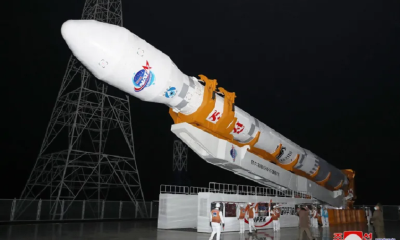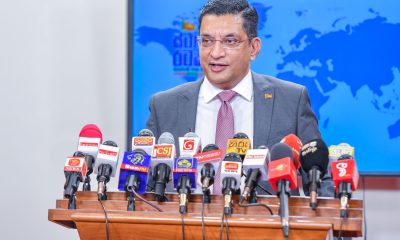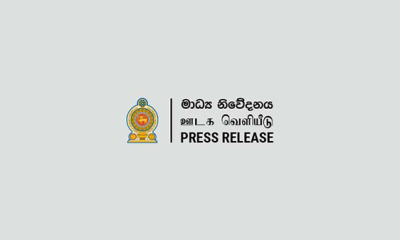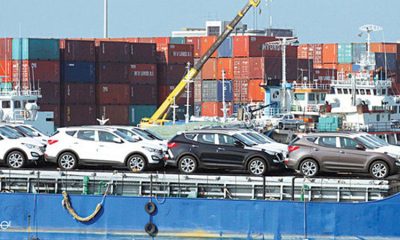Features
More on Japan, wonder woman Yukiko and an encounter in Tokyo’s red light area
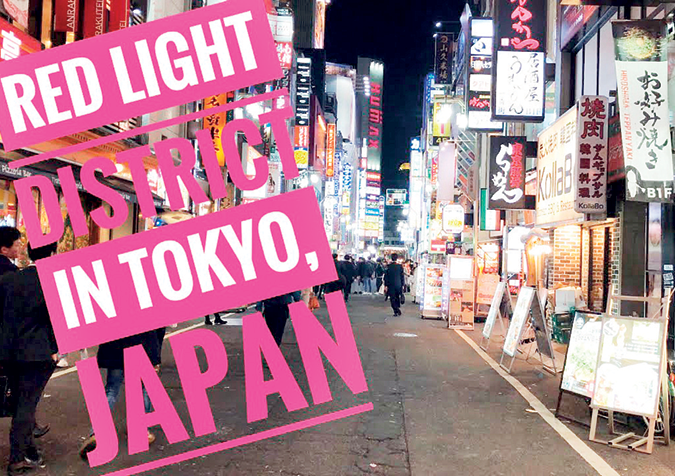
(Excerpted from Memories that Linger: My journey through the world of disability by Padmani Mendis)
While at ESCAP in Bangkok, Yukiko invited me to travel with her to the Maldives in 1988 and to Laos in 1989 to discuss CBR at National Workshops on disability sponsored in those countries by ESCAP. For many disabled people in those countries, it was their first opportunity to participate in an event such as this. And for as many, to meet a disabled person from another culture.
I will share one experience in Vientiane which illustrates Yukiko’s perfect fit in the role she carries out. We had finished dinner at a hotel not far from where we resided. There was not much traffic at that time of night, and we walked on the road itself. Yukiko was quite tiny in build. Because of impairment, Yukiko used a pair of crutches and walked very slowly. When I saw a large truck approaching us I said to her, “Yukiko, see that truck? Let’s move aside.” Her determined reply was, “Why should we? They can see us.” To me, that says it all.
Back home in Japan at the end of her three years, Yukiko set up the Asia Disability Institute or ADI to enable formal support for disability both within her own country and in others. Once, when I was in Tokyo, Yukiko and Shoji invited me to stay in their home. Yukiko took the opportunity to invite members of ADI for a meeting that evening. In the morning she told me she had to go to the supermarket to buy some stuff to prepare food for her guests. She asked me whether I would like to join her.
Yukiko had by this time discarded her cumbersome crutches, and with that, discarded the confinement that conventional rehabilitation had imposed on her. She exerted her right to choose. And she had chosen to use an electric wheelchair.
And what an experience it was for me going shopping with Yukiko. Out though the door and on the street, she just whizzed along at such a pace that I had to run alongside to keep up. Eventually I had to give up and just follow her. Inside the supermarket was another experience. She whizzed again in and out and along the aisles picking out what she wanted off the shelves and popping them into the bag hanging on her chair. We were soon done. I had been but an observer, but I was exhausted just watching her.
Yukiko is the embodiment of independence. Of inclusion. Of freedom.
The Asia Disability Institute provides a forum in which disabled people and professionals come together to discuss disability issues and to discuss possible solutions. It provides excellent opportunities where an understanding on these matters can be reached through debate and discussion. Sometimes the focus was on Community Based Rehabilitation (CBR). A hot topic for discussion at the time was disability-inclusion and participation. On one occasion when I went to Japan, Yukiko arranged for me to share my experience at a large symposium organised by the University of Tokyo. This was in 2001.
The topic I was to share was, “The Inclusion of Persons with Disabilities in the Community through Community-Based Rehabilitation, CBR”.
What’s in a name?
What’s in a name? That which we call a rose
By any other name would smell just as sweet.
William Shakespeare in ‘Romeo and Juliet’
Recently, I read about a large international forum discussing whether the words CBR should be replaced by Community-Based Inclusive Development. Some international organisations have Disability-Inclusive Development policies. Two comments: one is that we have learned globally through bitter experience that development must start with people, with the communities in which they live, start with a community-base. Imposing development from above brings no success. So prefixing the words “community-based” for development may be unnecessary.
Two, CBR is the strategy that has shown the way to disability inclusion in all development systems at all levels. What is important now is to ensure disability is included in development And call it what you will, until we find something better the strategy for disability inclusion will continue to be CBR.
What is a community?
By this time I had acquired a deep understanding of the “Community” in CBR. I am no sociologist and here I offer what I have learned on my journey. I believe that any one society is made up of a number of communities, one might say even a hierarchy of communities.
Starting with the very primary or neighbourhood community in which each of us lives, then in our immediate surroundings we may belong to women’s groups, youth groups and religious groups. Each individual thus belongs to many communities at the same time. Others may be common interest groups, professional bodies, sports, recreation and leisure groups, service clubs, development committees and councils and so on.
To me, the concept of disability inclusion must invade and permeate all these communities so that within society itself inclusion is built on a holistic foundation. CBR is a strategy that makes such inclusion and participation possible.
Moving with the Japanese
During the years that followed I was a frequent visitor to Japan. Formal addresses at the Universities of Nagoya and that of Osaka. Lecture tours and workshops to meet disabled people, physiotherapists, occupational therapists, NGOs and other professionals. On many of these I was accompanied by Masayuko Watanabe, himself a physiotherapist with an abiding interest in CBR.
A remarkable experience I had at this time was a very prestigious invitation to JICA headquarters for a meeting on CBR on JICA-NET. This was a video network used to bring together participants from JICA supported countries through video or internet conferencing. While the focal point was at the very modern JICA headquarters in Tokyo, JICA country offices were connected to this and to each other.
We had a very interesting and long discussion on CBR with Japanese disabled people and others associated with JICA in their member countries. Yukiko was the meeting facilitator. At that time this technology was a rarity and the meeting was a privilege. It has now been replaced by zoom and is an everyday occurrence.
Social Work Research Institute of the Japan College of Social Work
Meanwhile, the Asia-Pacific Decade of Disabled Persons declared by the UN which started in 1992 was coming to an end. At this time, the Social Work Research Institute of the Japan College of Social Work launched an initiative in the form of a research study. This was conducted from 2001 through to 2003. The study examined the outcomes of the decade within the region for the preparation of policies and strategies to ensure continuity of its impact.
Countries invited to participate in the study were Australia, Cambodia, China, Indonesia, Japan, Mongolia, the Philippines, Singapore, Sri Lanka, Thailand, USA and Vietnam, and ESCAP. Representatives from these countries and ESCAP were invited to Tokyo each year to meet and share findings. I was invited to represent Sri Lanka.
Comprehensive reports of the study were published each year and called the “International Comparative Study on Disability Policies and Programmes in the 21st Century in Asia and the Pacific”.
An experience in Shinjuku
At the yearly meetings working days were heavy. Some of us needed to get away in the evenings to relax and be refreshed for the next day. On the humorous side, there is a memory I like to recall when I am asked about my experiences.
The American, the Thai and I soon became a close-knit trio. I have never understood how strangers come together to form a friendship group in such a short time. Alas, these are temporary. During that short time, we would spend the evenings enjoying whatever we could of Shinjuku where we were located. Shinjuku itself, though a ward of Tokyo, is very large. There was no way we could use the subway by ourselves. Signage in English was rare. But there was plenty to be enjoyed traversing Shinjuku on our feet.
And so the three of us found ourselves one evening in Tokyo’s Red Light District. John the size XXXL American in the middle and on either side of him the M-sized, sareed me and the S-minus Thai lady Gini. An unexpected threesome striding along, looking quite out of place in this bustling area, full of lights and of colour and of a particular kind of activity.
And then came to us a young man to ask, “You want girl? You want boy? You want boy and girl? See my photos?” with which he proceeded to show us proudly what he had to offer. Other young men started encircling us. The scene was becoming somewhat threatening.
John, the XXXL American, grabbed each of us by our elbows. We fled. We found a Starbucks at a safe distance. Where we sat and laughed our sides out over a world-renowned cup of American coffee. The first I had tasted of that brand. And have never drunk since. Nothing but prejudice of course.
Japan Overseas Volunteer Corps
Sri Lanka has been a close friend and a programme country of Japan for many decades. For the last forty years or more, we have being helped by the Japan Overseas Volunteer Corps or JOCV. Sri Lanka has had volunteers from Japan in the field of agriculture, forestry, education and health amongst other technical fields. They come to Sri Lanka quite conversant in our local languages and work closely with our people. We have had them help us in CBR too. Every year, about half a dozen find accommodation in the villages to work with local groups and with the area Social Service Officers.
Naoko Kato, the JOCV coordinator based in the embassy, made it a habit to bring to me for an unofficial briefing those that would work in disability before they went to their respective posts. Soon I was appointed as an official Adviser on Disability to the JOCV, Colombo. I continued as one for a few years. I must say the fluency volunteers showed in my mother tongue exceeded my own.
One day I was in discussion with the Director of Inclusive Education at the National Institute of Education in his office at Maharagama. I was with my back to the door. While we were talking, there was a tap on the door. It opened, and a female voice conversed with him in Sinhala for a few short minutes. I looked over my shoulder and saw it was a pretty young lady in Kandyan saree. When she had gone, I asked the director who it was. He replied, “Oh that is our Japanese volunteer.”
I had truly believed she was from the Kandyan areas for the fluency with which she used Sinhala. Moreover, she carried off that saree so gracefully – as though she had been born for it.
Features
The heart-friendly health minister

by Dr Gotabhya Ranasinghe
Senior Consultant Cardiologist
National Hospital Sri Lanka
When we sought a meeting with Hon Dr. Ramesh Pathirana, Minister of Health, he graciously cleared his busy schedule to accommodate us. Renowned for his attentive listening and deep understanding, Minister Pathirana is dedicated to advancing the health sector. His openness and transparency exemplify the qualities of an exemplary politician and minister.
Dr. Palitha Mahipala, the current Health Secretary, demonstrates both commendable enthusiasm and unwavering support. This combination of attributes makes him a highly compatible colleague for the esteemed Minister of Health.
Our discussion centered on a project that has been in the works for the past 30 years, one that no other minister had managed to advance.
Minister Pathirana, however, recognized the project’s significance and its potential to revolutionize care for heart patients.
The project involves the construction of a state-of-the-art facility at the premises of the National Hospital Colombo. The project’s location within the premises of the National Hospital underscores its importance and relevance to the healthcare infrastructure of the nation.
This facility will include a cardiology building and a tertiary care center, equipped with the latest technology to handle and treat all types of heart-related conditions and surgeries.
Securing funding was a major milestone for this initiative. Minister Pathirana successfully obtained approval for a $40 billion loan from the Asian Development Bank. With the funding in place, the foundation stone is scheduled to be laid in September this year, and construction will begin in January 2025.
This project guarantees a consistent and uninterrupted supply of stents and related medications for heart patients. As a result, patients will have timely access to essential medical supplies during their treatment and recovery. By securing these critical resources, the project aims to enhance patient outcomes, minimize treatment delays, and maintain the highest standards of cardiac care.
Upon its fruition, this monumental building will serve as a beacon of hope and healing, symbolizing the unwavering dedication to improving patient outcomes and fostering a healthier society.We anticipate a future marked by significant progress and positive outcomes in Sri Lanka’s cardiovascular treatment landscape within the foreseeable timeframe.
Features
A LOVING TRIBUTE TO JESUIT FR. ALOYSIUS PIERIS ON HIS 90th BIRTHDAY

by Fr. Emmanuel Fernando, OMI
Jesuit Fr. Aloysius Pieris (affectionately called Fr. Aloy) celebrated his 90th birthday on April 9, 2024 and I, as the editor of our Oblate Journal, THE MISSIONARY OBLATE had gone to press by that time. Immediately I decided to publish an article, appreciating the untiring selfless services he continues to offer for inter-Faith dialogue, the renewal of the Catholic Church, his concern for the poor and the suffering Sri Lankan masses and to me, the present writer.
It was in 1988, when I was appointed Director of the Oblate Scholastics at Ampitiya by the then Oblate Provincial Fr. Anselm Silva, that I came to know Fr. Aloy more closely. Knowing well his expertise in matters spiritual, theological, Indological and pastoral, and with the collaborative spirit of my companion-formators, our Oblate Scholastics were sent to Tulana, the Research and Encounter Centre, Kelaniya, of which he is the Founder-Director, for ‘exposure-programmes’ on matters spiritual, biblical, theological and pastoral. Some of these dimensions according to my view and that of my companion-formators, were not available at the National Seminary, Ampitiya.
Ever since that time, our Oblate formators/ accompaniers at the Oblate Scholasticate, Ampitiya , have continued to send our Oblate Scholastics to Tulana Centre for deepening their insights and convictions regarding matters needed to serve the people in today’s context. Fr. Aloy also had tried very enthusiastically with the Oblate team headed by Frs. Oswald Firth and Clement Waidyasekara to begin a Theologate, directed by the Religious Congregations in Sri Lanka, for the contextual formation/ accompaniment of their members. It should very well be a desired goal of the Leaders / Provincials of the Religious Congregations.
Besides being a formator/accompanier at the Oblate Scholasticate, I was entrusted also with the task of editing and publishing our Oblate journal, ‘The Missionary Oblate’. To maintain the quality of the journal I continue to depend on Fr. Aloy for his thought-provoking and stimulating articles on Biblical Spirituality, Biblical Theology and Ecclesiology. I am very grateful to him for his generous assistance. Of late, his writings on renewal of the Church, initiated by Pope St. John XX111 and continued by Pope Francis through the Synodal path, published in our Oblate journal, enable our readers to focus their attention also on the needed renewal in the Catholic Church in Sri Lanka. Fr. Aloy appreciated very much the Synodal path adopted by the Jesuit Pope Francis for the renewal of the Church, rooted very much on prayerful discernment. In my Religious and presbyteral life, Fr.Aloy continues to be my spiritual animator / guide and ongoing formator / acccompanier.
Fr. Aloysius Pieris, BA Hons (Lond), LPh (SHC, India), STL (PFT, Naples), PhD (SLU/VC), ThD (Tilburg), D.Ltt (KU), has been one of the eminent Asian theologians well recognized internationally and one who has lectured and held visiting chairs in many universities both in the West and in the East. Many members of Religious Congregations from Asian countries have benefited from his lectures and guidance in the East Asian Pastoral Institute (EAPI) in Manila, Philippines. He had been a Theologian consulted by the Federation of Asian Bishops’ Conferences for many years. During his professorship at the Gregorian University in Rome, he was called to be a member of a special group of advisers on other religions consulted by Pope Paul VI.
Fr. Aloy is the author of more than 30 books and well over 500 Research Papers. Some of his books and articles have been translated and published in several countries. Among those books, one can find the following: 1) The Genesis of an Asian Theology of Liberation (An Autobiographical Excursus on the Art of Theologising in Asia, 2) An Asian Theology of Liberation, 3) Providential Timeliness of Vatican 11 (a long-overdue halt to a scandalous millennium, 4) Give Vatican 11 a chance, 5) Leadership in the Church, 6) Relishing our faith in working for justice (Themes for study and discussion), 7) A Message meant mainly, not exclusively for Jesuits (Background information necessary for helping Francis renew the Church), 8) Lent in Lanka (Reflections and Resolutions, 9) Love meets wisdom (A Christian Experience of Buddhism, 10) Fire and Water 11) God’s Reign for God’s poor, 12) Our Unhiddden Agenda (How we Jesuits work, pray and form our men). He is also the Editor of two journals, Vagdevi, Journal of Religious Reflection and Dialogue, New Series.
Fr. Aloy has a BA in Pali and Sanskrit from the University of London and a Ph.D in Buddhist Philosophy from the University of Sri Lankan, Vidyodaya Campus. On Nov. 23, 2019, he was awarded the prestigious honorary Doctorate of Literature (D.Litt) by the Chancellor of the University of Kelaniya, the Most Venerable Welamitiyawe Dharmakirthi Sri Kusala Dhamma Thera.
Fr. Aloy continues to be a promoter of Gospel values and virtues. Justice as a constitutive dimension of love and social concern for the downtrodden masses are very much noted in his life and work. He had very much appreciated the commitment of the late Fr. Joseph (Joe) Fernando, the National Director of the Social and Economic Centre (SEDEC) for the poor.
In Sri Lanka, a few religious Congregations – the Good Shepherd Sisters, the Christian Brothers, the Marist Brothers and the Oblates – have invited him to animate their members especially during their Provincial Congresses, Chapters and International Conferences. The mainline Christian Churches also have sought his advice and followed his seminars. I, for one, regret very much, that the Sri Lankan authorities of the Catholic Church –today’s Hierarchy—- have not sought Fr.
Aloy’s expertise for the renewal of the Catholic Church in Sri Lanka and thus have not benefited from the immense store of wisdom and insight that he can offer to our local Church while the Sri Lankan bishops who governed the Catholic church in the immediate aftermath of the Second Vatican Council (Edmund Fernando OMI, Anthony de Saram, Leo Nanayakkara OSB, Frank Marcus Fernando, Paul Perera,) visited him and consulted him on many matters. Among the Tamil Bishops, Bishop Rayappu Joseph was keeping close contact with him and Bishop J. Deogupillai hosted him and his team visiting him after the horrible Black July massacre of Tamils.
Features
A fairy tale, success or debacle

Sri Lanka-Singapore Free Trade Agreement
By Gomi Senadhira
senadhiragomi@gmail.com
“You might tell fairy tales, but the progress of a country cannot be achieved through such narratives. A country cannot be developed by making false promises. The country moved backward because of the electoral promises made by political parties throughout time. We have witnessed that the ultimate result of this is the country becoming bankrupt. Unfortunately, many segments of the population have not come to realize this yet.” – President Ranil Wickremesinghe, 2024 Budget speech
Any Sri Lankan would agree with the above words of President Wickremesinghe on the false promises our politicians and officials make and the fairy tales they narrate which bankrupted this country. So, to understand this, let’s look at one such fairy tale with lots of false promises; Ranil Wickremesinghe’s greatest achievement in the area of international trade and investment promotion during the Yahapalana period, Sri Lanka-Singapore Free Trade Agreement (SLSFTA).
It is appropriate and timely to do it now as Finance Minister Wickremesinghe has just presented to parliament a bill on the National Policy on Economic Transformation which includes the establishment of an Office for International Trade and the Sri Lanka Institute of Economics and International Trade.
Was SLSFTA a “Cleverly negotiated Free Trade Agreement” as stated by the (former) Minister of Development Strategies and International Trade Malik Samarawickrama during the Parliamentary Debate on the SLSFTA in July 2018, or a colossal blunder covered up with lies, false promises, and fairy tales? After SLSFTA was signed there were a number of fairy tales published on this agreement by the Ministry of Development Strategies and International, Institute of Policy Studies, and others.
However, for this article, I would like to limit my comments to the speech by Minister Samarawickrama during the Parliamentary Debate, and the two most important areas in the agreement which were covered up with lies, fairy tales, and false promises, namely: revenue loss for Sri Lanka and Investment from Singapore. On the other important area, “Waste products dumping” I do not want to comment here as I have written extensively on the issue.
1. The revenue loss
During the Parliamentary Debate in July 2018, Minister Samarawickrama stated “…. let me reiterate that this FTA with Singapore has been very cleverly negotiated by us…. The liberalisation programme under this FTA has been carefully designed to have the least impact on domestic industry and revenue collection. We have included all revenue sensitive items in the negative list of items which will not be subject to removal of tariff. Therefore, 97.8% revenue from Customs duty is protected. Our tariff liberalisation will take place over a period of 12-15 years! In fact, the revenue earned through tariffs on goods imported from Singapore last year was Rs. 35 billion.
The revenue loss for over the next 15 years due to the FTA is only Rs. 733 million– which when annualised, on average, is just Rs. 51 million. That is just 0.14% per year! So anyone who claims the Singapore FTA causes revenue loss to the Government cannot do basic arithmetic! Mr. Speaker, in conclusion, I call on my fellow members of this House – don’t mislead the public with baseless criticism that is not grounded in facts. Don’t look at petty politics and use these issues for your own political survival.”
I was surprised to read the minister’s speech because an article published in January 2018 in “The Straits Times“, based on information released by the Singaporean Negotiators stated, “…. With the FTA, tariff savings for Singapore exports are estimated to hit $10 million annually“.
As the annual tariff savings (that is the revenue loss for Sri Lanka) calculated by the Singaporean Negotiators, Singaporean $ 10 million (Sri Lankan rupees 1,200 million in 2018) was way above the rupees’ 733 million revenue loss for 15 years estimated by the Sri Lankan negotiators, it was clear to any observer that one of the parties to the agreement had not done the basic arithmetic!
Six years later, according to a report published by “The Morning” newspaper, speaking at the Committee on Public Finance (COPF) on 7th May 2024, Mr Samarawickrama’s chief trade negotiator K.J. Weerasinghehad had admitted “…. that forecasted revenue loss for the Government of Sri Lanka through the Singapore FTA is Rs. 450 million in 2023 and Rs. 1.3 billion in 2024.”
If these numbers are correct, as tariff liberalisation under the SLSFTA has just started, we will pass Rs 2 billion very soon. Then, the question is how Sri Lanka’s trade negotiators made such a colossal blunder. Didn’t they do their basic arithmetic? If they didn’t know how to do basic arithmetic they should have at least done their basic readings. For example, the headline of the article published in The Straits Times in January 2018 was “Singapore, Sri Lanka sign FTA, annual savings of $10m expected”.
Anyway, as Sri Lanka’s chief negotiator reiterated at the COPF meeting that “…. since 99% of the tariffs in Singapore have zero rates of duty, Sri Lanka has agreed on 80% tariff liberalisation over a period of 15 years while expecting Singapore investments to address the imbalance in trade,” let’s turn towards investment.
Investment from Singapore
In July 2018, speaking during the Parliamentary Debate on the FTA this is what Minister Malik Samarawickrama stated on investment from Singapore, “Already, thanks to this FTA, in just the past two-and-a-half months since the agreement came into effect we have received a proposal from Singapore for investment amounting to $ 14.8 billion in an oil refinery for export of petroleum products. In addition, we have proposals for a steel manufacturing plant for exports ($ 1 billion investment), flour milling plant ($ 50 million), sugar refinery ($ 200 million). This adds up to more than $ 16.05 billion in the pipeline on these projects alone.
And all of these projects will create thousands of more jobs for our people. In principle approval has already been granted by the BOI and the investors are awaiting the release of land the environmental approvals to commence the project.
I request the Opposition and those with vested interests to change their narrow-minded thinking and join us to develop our country. We must always look at what is best for the whole community, not just the few who may oppose. We owe it to our people to courageously take decisions that will change their lives for the better.”
According to the media report I quoted earlier, speaking at the Committee on Public Finance (COPF) Chief Negotiator Weerasinghe has admitted that Sri Lanka was not happy with overall Singapore investments that have come in the past few years in return for the trade liberalisation under the Singapore-Sri Lanka Free Trade Agreement. He has added that between 2021 and 2023 the total investment from Singapore had been around $162 million!
What happened to those projects worth $16 billion negotiated, thanks to the SLSFTA, in just the two-and-a-half months after the agreement came into effect and approved by the BOI? I do not know about the steel manufacturing plant for exports ($ 1 billion investment), flour milling plant ($ 50 million) and sugar refinery ($ 200 million).
However, story of the multibillion-dollar investment in the Petroleum Refinery unfolded in a manner that would qualify it as the best fairy tale with false promises presented by our politicians and the officials, prior to 2019 elections.
Though many Sri Lankans got to know, through the media which repeatedly highlighted a plethora of issues surrounding the project and the questionable credentials of the Singaporean investor, the construction work on the Mirrijiwela Oil Refinery along with the cement factory began on the24th of March 2019 with a bang and Minister Ranil Wickremesinghe and his ministers along with the foreign and local dignitaries laid the foundation stones.
That was few months before the 2019 Presidential elections. Inaugurating the construction work Prime Minister Ranil Wickremesinghe said the projects will create thousands of job opportunities in the area and surrounding districts.
The oil refinery, which was to be built over 200 acres of land, with the capacity to refine 200,000 barrels of crude oil per day, was to generate US$7 billion of exports and create 1,500 direct and 3,000 indirect jobs. The construction of the refinery was to be completed in 44 months. Four years later, in August 2023 the Cabinet of Ministers approved the proposal presented by President Ranil Wickremesinghe to cancel the agreement with the investors of the refinery as the project has not been implemented! Can they explain to the country how much money was wasted to produce that fairy tale?
It is obvious that the President, ministers, and officials had made huge blunders and had deliberately misled the public and the parliament on the revenue loss and potential investment from SLSFTA with fairy tales and false promises.
As the president himself said, a country cannot be developed by making false promises or with fairy tales and these false promises and fairy tales had bankrupted the country. “Unfortunately, many segments of the population have not come to realize this yet”.
(The writer, a specialist and an activist on trade and development issues . )




